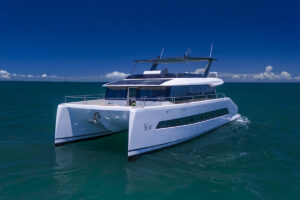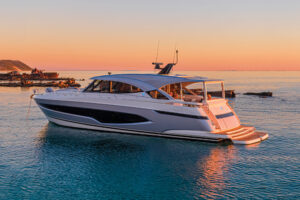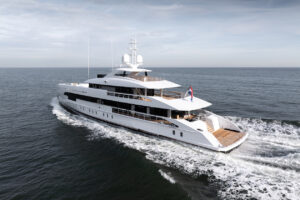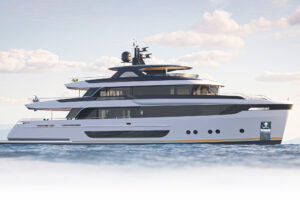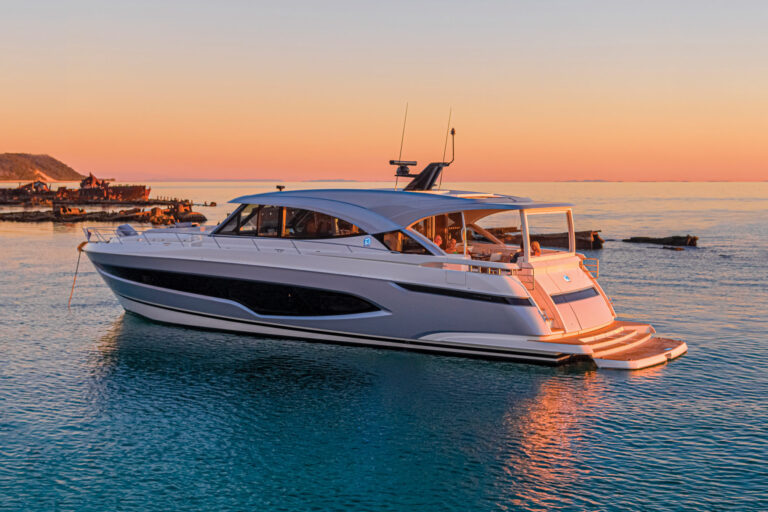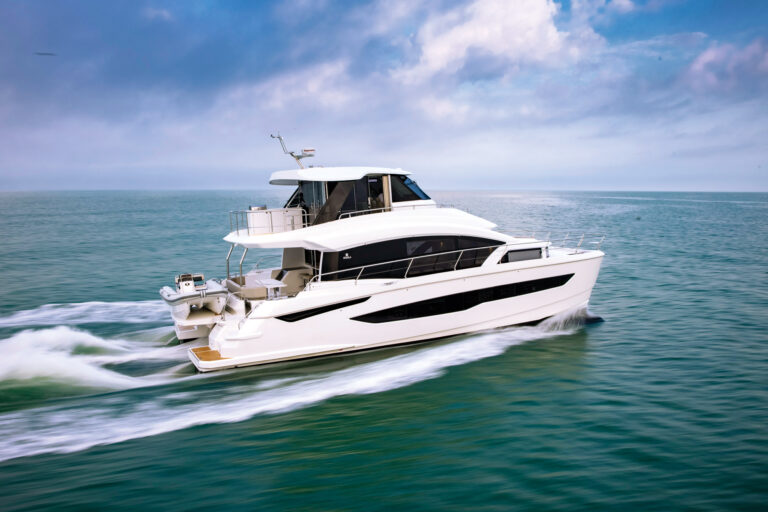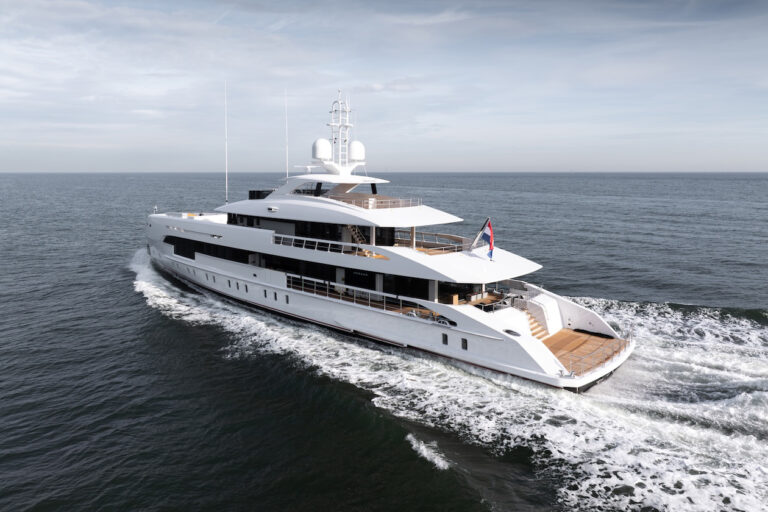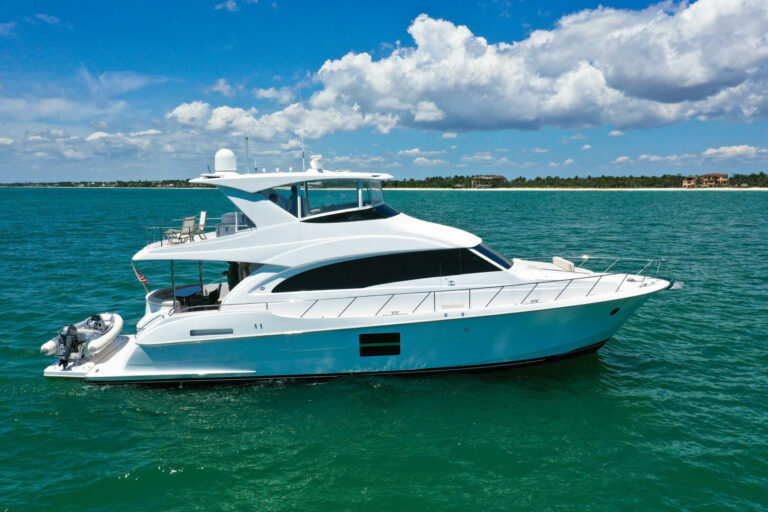For those who remember the 1960s, Jimmy Dean and the country ballad “Big Bad John” are inseparable. It would be another decade or two before packages of premium sausage bore Dean’s name, and even there, his roots remained prominent in the form of a cowboy boot in the logo.
Considering this history, it’s no surprise Dean christened each of his yachts Big Bad John. The latest to carry the name is a sleek motoryacht from Christensen Yachts’ busy Vancouver, Washington, yard. An experienced yachtsman, Dean had definite ideas for this yacht, and the result is more a symphony than a ballad. The consonance of design has yielded a vessel that is not simple, yet the disparate parts combine to deliver an exceptionally pleasing whole that’s as smooth as pure harmony.
At 140 feet, Big Bad John is one of the longest yachts in memory to utilize a raised pilothouse. Most yachts of this length would carry at least a full pilothouse, and perhaps even a full third deck. Dean, however, wanted something more evocative of motion and made a deliberate choice to go long rather than high to achieve the space he wanted.
It is a wise choice from both aesthetic and technical standpoints. Visually, Big Bad John looks like she’s moving even when she’s standing still, and that fluidity is only partly illusion. By keeping the profile low, the beam can be a foot or so narrower than that on a three-deck yacht without compromising stability. This increases the length/beam ratio, an important factor in reducing resistance and power requirements, and in increasing range. There is more hull bottom area for a given displacement, lowering the bottom loading and improving performance further. The lower profile of Big Bad John also means less windage and a lower vertical center of gravity. These characteristics result in less rolling at sea and at anchor, counteracting the reduced beam and providing increased comfort and safety.
Another unusual design choice is the asymmetrical arrangement: the saloon and dining room are full-beam to port, walkaround to starboard. The arrangement works-for the owner, because it offers more interior area; for the crew, because it provides space to work the yacht in port and at sea. Large yachts invariably tie up starboard side to, so there’s seldom any true purpose for a portside deck. If you think the arrangement might look strange, keep in mind that it is nearly impossible to see both sides of the boat at once. Even so, Setzer Design Group did a great job of keeping the two sides similar. Only a careful observer will notice the difference.
The asymmetry continues below-decks in the master stateroom, where the berth is shifted to starboard, leaving space to port for a comfortable sitting area. The berth is attractively finished in the same medium-tone satin mahogany used throughout the interior, and is capped by a dropped tray that creates the impression of a canopy bed while inconspicuously housing the air-conditioning ductwork. The master baths are also dissimilar. Hers is a bit larger, with a full tub and spacious vanity, and his is fitted with a shower. Two large walk-in lockers round out the master accommodations.
Two identical guest staterooms are forward of the master stateroom. Each has a queen berth and spacious hanging locker, and the en suite baths are equipped with tubs. A captain’s cabin rivaling the guest accommodations in size is forward, as are two crew cabins, a crew mess and a laundry room. An exercise room is to port, between the master and guest staterooms, in a space large enough to house a third guest cabin.
Between the guest and crew spaces is a short passageway with a door at each end and stowage lockers to either side. Not only does this clever connector allow the crew to carry out their housekeeping chores easily and efficiently, it provides an important second route of escape in the event of fire or other emergency in either space.
Forward of the pilothouse on the main deck are large stowage areas under the brow and an open galley and dinette that will be a favorite informal gathering area for crew and guests alike. A passageway to port of the pilothouse will serve multiple duties. During formal dinners, it is the service route between the dining room and the galley; in port, it will be handy for bringing supplies into the galley, the stowage areas under the pilothouse and the brow, and the crew area belowdecks. To starboard are an entry foyer and a day head, as well as stairways down to the accommodations and up to the pilothouse and boat deck.
The dining room is open to the saloon, but separated by a low divider cabinet and hefty columns. The table is centered to port, leaving room for a sizable bar to starboard. The saloon isn’t quite full-beam-remember the side deck to starboard only-but is wide enough for the several large settees and chairs clustered around a grand piano. The furniture, the carpet and the overhead are done in light, complementary hues that bring out the best in the satin mahogany paneling. They create a space I find especially attractive and inviting, even without an evening of music by the master.
On the flying bridge, four companion seats flank the captain’s chair. A huge table to starboard with an L-shape settee is just abaft the seats. A wet bar seating six is to port, and a row of individual sun lounges is beneath the radar arch. A pair of canister liferafts and a large RIB tender handled by a centerline davit stow aft.
Big Bad John is just about everything a yacht should be. She was designed to suit the particular tastes and specific requirements of an experienced owner who wasn’t afraid to break a few rules. She was solidly built by a well-respected yard, to the high standards of ABS class and MCA certification. Her interior is warm, comfortable and upscale without being pretentious. Rather than being stored in some remote marina, the yacht is moored behind the owner’s home, where she will receive constant attention. Perhaps best of all, she is owned by a yachtsman who will cruise extensively, providing a great deal of pleasure to himself, to his family and friends, and to all those who might be fortunate enough to spot John cruising by.
Big, yes. Bad, no way.
Contact: Christensen Yachts, (360) 695-3238; fax (360) 695-3252; info@christensenyachts.com; www.christensenyachts.com. Setzer Design Group, (919) 319-0559; fax (919) 319-0557.

